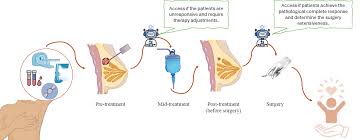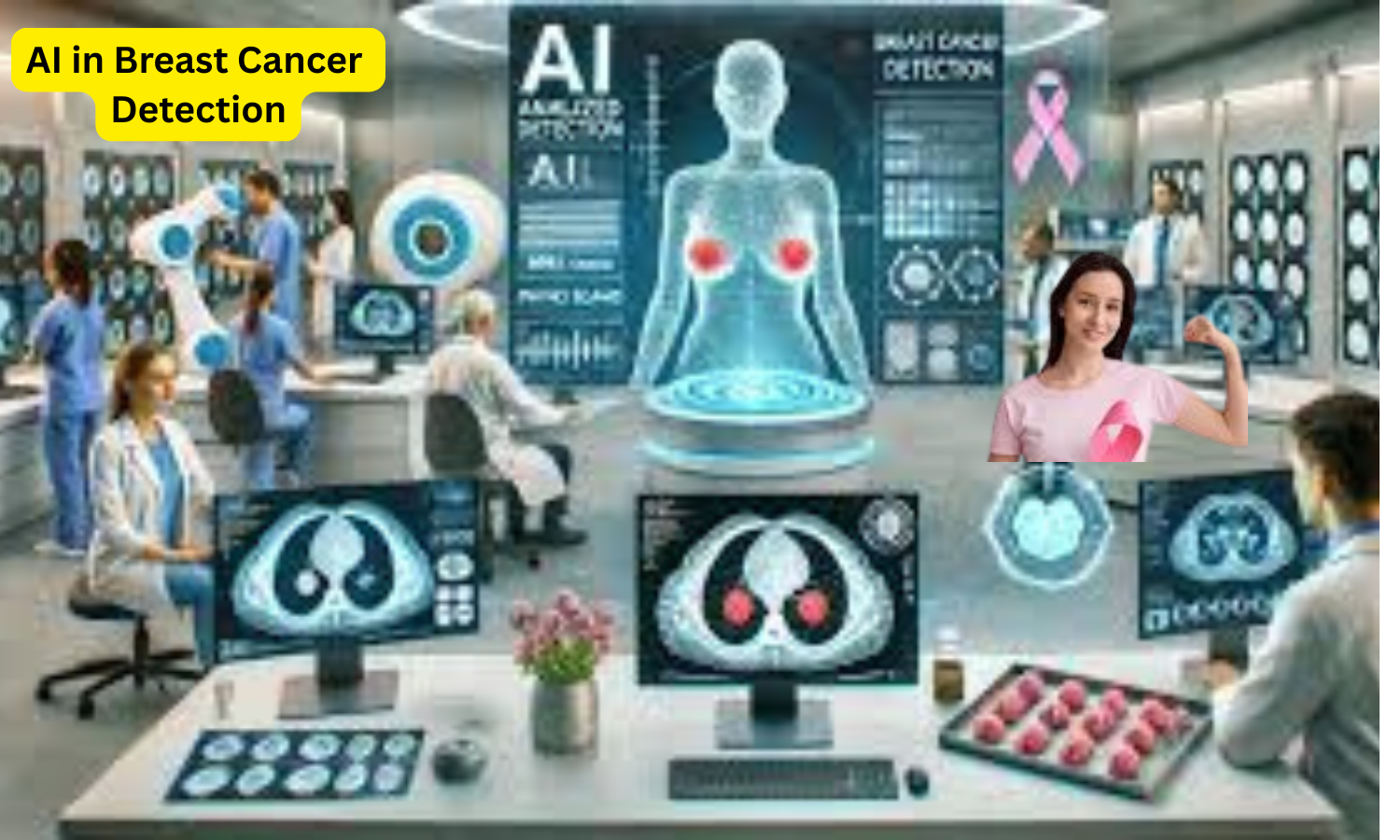Table of contents
AI-Powered Imaging Enhances Early Detection
Machine Learning Improves Pathology Analysis
Real-Time AI Screening Boosts Diagnostic Accuracy
AI’s Role in Personalized Breast Cancer Treatment
Precision Medicine Tailors Treatment Plans
Predictive Analytics Forecasts Disease Progression
AI Supports Immunotherapy Advancements
AI Innovations Driving Surgical and Post-Treatment Care
AI-Driven Drug Discovery Accelerates Treatment Development
AI Monitors Post-Treatment Recovery
Introduction

Breast cancer is among the leading causes of cancer-related deaths that have taken women’s lives. What can change the fatality figures of this cancer is early detection and getting the right treatment. As a result, Artificial Intelligence (AI) is recognized as a major factor in the complete transformation of how doctors detect, diagnose, and treat breast cancer. AI, in fact, is a combination of machine learning, deep learning, and predictive analytics, which brings new features to breast cancer care in terms of accuracy, speed, and personalization that have never been seen before. This article communicates the revolutionary methods of AI for the detection and treatment of breast cancer.
AI in Breast Cancer Detection

The foundation of better results in breast cancer is early and precise detection. AI contributes to diagnosis from the perspectives of medical imaging and pathological examination, thereby minimizing human errors and enhancing diagnostic speed.
AI-Powered Imaging Enhances Early Detection
Mammography is the primary screening tool for breast cancer; however, it has limitations in detecting faint signs in the case of dense breast tissue. The precision of AI-driven imaging software is attributed to its deep learning feature, which can process thousands of mammograms and find even faint patterns that a human cannot see. With the help of these AI models, radiologists can identify which parts of the breast are masking early-stage tumors, thereby finding the latter with high accuracy.
Advantages:
* Cancer is detected at an earlier stage
* The cases of false positives and unnecessary biopsies are minimized
* The efficiency of a radiologist and his confidence are enhanced
Machine Learning Improves Pathology Analysis
The examination of the tissue samples under the microscope by pathologists had been a traditional, slow, and sometimes subjective process. With the help of AI algorithms that, in fact, analyze the digitalized biopsy images, the identification of malignant and benign cells can be done with a very high level of accuracy. Besides, through AI, diagnosis is accelerated since AI recognizes the morphological changes of cells and the architecture of tissue that are the most subtle, which pathologists have less chance of misclassifying, and which, in turn, reduces the possibility of errors.
Benefits:
* Pathology workflows are sped up
* Accuracy in the differentiation of cancer types is improved
* Early treatment initiation is facilitated
Real-Time AI Screening Boosts Diagnostic Accuracy
Current AI capabilities are designed to synergize with screening instruments, thus providing instant feedback during mammograms or ultrasounds. Real-time assessments assisted by these machines enable doctors to make decisions more efficiently; therefore, the follow-up is done quickly for the suspicious findings.
Benefits:
* Anomalies are detected immediately
* The patient’s best care is ensured during screening
* The diagnosis is done without waiting
AI’s Role in Personalized Breast Cancer Treatment
One size never fits all breast cancer patients, and, what is more, tumor cells may behave differently even among the same subgroup of patients with similar diagnoses.
With AI, human precision medicine becomes doable as treatment is planned according to the individual patient’s genetics, clinical, and molecular profiles.
Precision Medicine Tailors Treatment Plans

There, AI analyzes the patient-specific genomic data, and based on this, it highlights mutations and biomarkers that impact the patient’s response to therapy. AI’s main role is, in effect, to be the vehicle that takes us there, where the perfect match between patient and therapy is realized; thus, as a result, the treatment effectiveness is improved and the side effects are minimized. One example could be where AI forecasts that a patient will have a better response when given chemotherapy rather than hormone or targeted therapy.
Benefits:
* Personalized therapy plans
* Treatment side effects are lessened
* Survival rates get better
Predictive Analytics Forecasts Disease Progression
With the patient’s history, tumor biology, and lifestyle taken into account, AI models are in a position to foretell breast cancer progression. Such predictive insights enable clinicians to be more agile in adjusting their treatment strategies, ensuring their intervention occurs before the disease becomes more severe.
Benefits:
* Predicts local recurrence or metastasis
* Guides the proactive treatment changes
* Strengthens the patient’s future health
AI Supports Immunotherapy Advancements
Immunotherapy, to begin with, is a treatment method that is promising for some breast cancers. AI finds the biomarkers and genetic signatures that indicate a patient’s response to immunotherapy. Therefore, it helps doctors to offer the therapy to the right patients who will benefit the most from the treatment.
Benefits:
* Immunotherapy selection is optimized
* Treatment success rates go up
* There is less trial-and-error in picking therapy
AI Innovations Driving Surgical and Post-Treatment Care
Beyond detection and therapy planning, AI is revolutionizing surgical accuracy and post-treatment care.
Robotic Surgery Enhances Precision

AI-supported robotic devices are the surgeons’ guides in the operations of breast-conserving surgeries and mastectomies. What is more, these tools lead to the highest effectiveness of cancer cell removal, contribute to the lowest tissue damage of the healthy part, and result in the smallest number of problems later on. After the surgery, these patients will have a quicker recovery time and have better results.
Benefits:
* The surgery is done with more precision
* Procedures are less invasive
* Recovery is quicker
AI-Driven Drug Discovery Accelerates Treatment Development
The process of coming up with new cancer drugs is very slow and costly most of the time. The acceleration of this process is the primary role of AI, which involves the analysis of molecular structures, the prediction of drug effectiveness, and the identification of the side-effect-causing agents long before clinical trials. What is more, this innovation allows the new therapies to be at the disposal of the patients much earlier; it also improves the overall success rate of drug development.
Benefits:
* Effective drugs are discovered faster
* Cost of clinical trials is reduced
* Novel treatments are introduced to patients sooner
AI Monitors Post-Treatment Recovery
AI wearable tools are there for recording the health of the patients post-treatment, which includes monitoring vital signs, hormone levels, and other indicators of recurrence. Such intelligent systems are there to notify the medical professionals of the first warning signs, thus allowing them to intervene on time and provide continuous support to cancer survivors.
Benefits:
* Recovery is constantly monitored
* Recurrence is detected early
* Breast cancer care is being completely redefined by AI across the entire spectrum of management that essentially comprises detection, diagnosis, treatment, and recovery.
AI integrates advanced imaging, machine learning, predictive analytics, and robotics in a way that it provides:
* A diagnosis that is faster and more accurate
* Treatment plans that are tailored for every single patient
* Side effects are reduced and recovery is improved
* The development of new therapies is accelerated
* There is continuous monitoring for recurrence
Conclusion
The AI technology kept updating and will definitely be able to profoundly solve the problem breast cancer poses to humanity, and in so doing, it will be able to increase the survival rate drastically and the quality of life of patients across the globe. The collaboration of AI researchers, clinicians, and healthcare systems will be important to achieve the full-blown impact of this technological revolution.
AI is unleashing infinite potential in breast cancer detection and treatment strategies. Pretty soon, breast cancer will be diagnosed at an earlier stage, treatment will be more efficient, and, if it is not eliminated, the disease will be managed with more success, thanks to substantial contributions made by AI, e.g., improved early diagnosis, personalization of therapy, and facilitation of drug discovery.


Leave a Reply